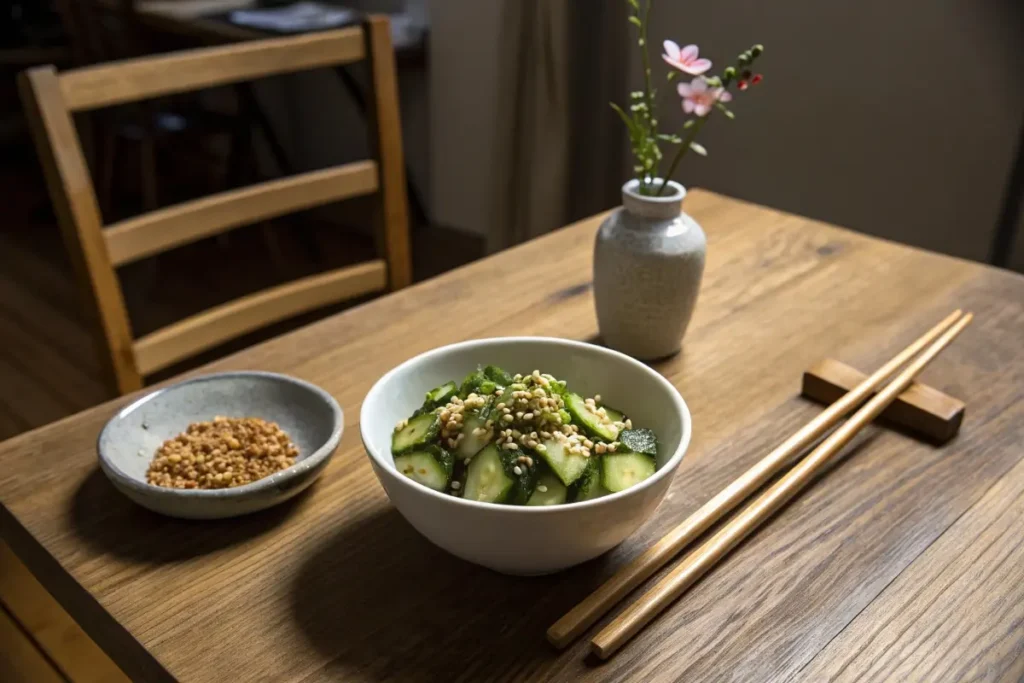If you’re in search of a light side dish that pairs well with just about any meal, japanese cucumber salad recipe—often called sunomono—is the answer. Within the first bite, you’ll notice how it’s both subtly sweet and tangy, delivering crisp cucumber texture in a delicate dressing. Questions like What is the difference between Tsukemono and sunomono? and Why soak cucumbers in salt water before making cucumber salad? often arise for newcomers.
In this article, we’ll cover all you need to know about Japanese cucumber salad, from its origin to step-by-step instructions. If you’re intrigued by bright, palate-cleansing dishes, you might also appreciate exploring our Vegetables Japanese Recipe to incorporate more fresh produce into your cooking routine. Let’s dive in!
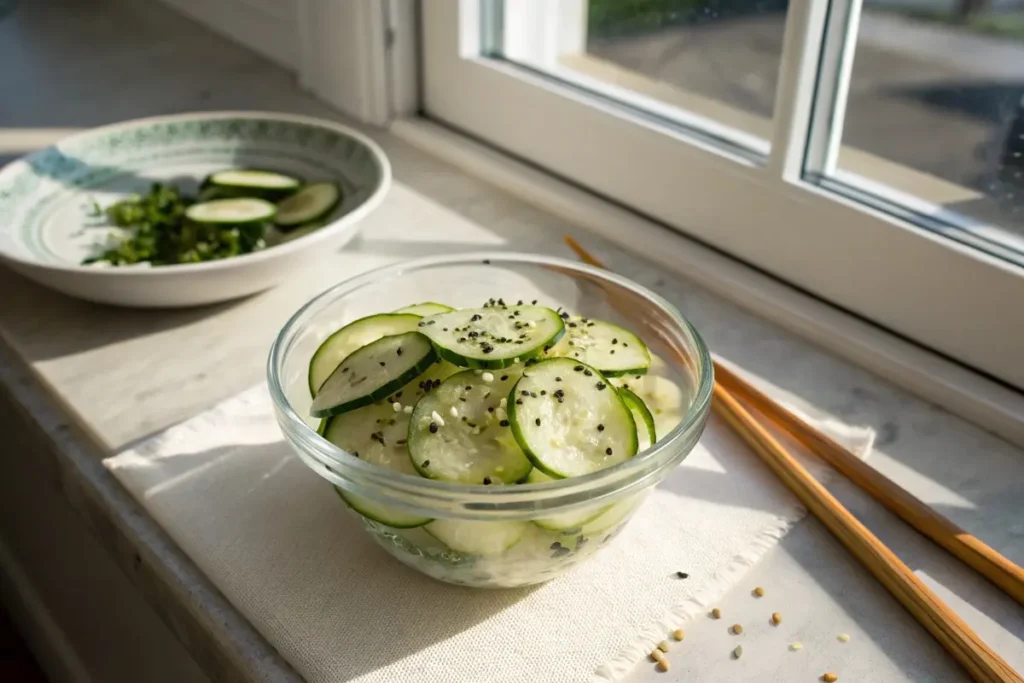
What Makes Japanese Cucumber Salad recipe (Sunomono) So Special
Japanese cucumber salad recipe, also known as sunomono, is a staple in many Japanese households and restaurants. The term “sunomono” literally translates to “vinegared things,” capturing the essence of its slightly sweet and tangy flavor profile. This dish is prized for its simplicity: crisp cucumbers, a balanced dressing, and optional garnishes such as sesame seeds or wakame seaweed.
The Sunomono vs. Tsukemono Question
If you’re wondering, What is the difference between Tsukemono and sunomono? it comes down to pickling duration and methods:
- Tsukemono: Refers to Japanese pickled vegetables. They can be brined in salt, vinegar, or even rice bran for extended periods, developing deeper flavors and sometimes pungent aromas.
- Sunomono (Cucumber Salad): Typically a quick-pickled dish, combined with a sweet and sour dressing right before serving. The cucumbers retain their fresh crunch rather than acquiring the deep pickled essence of tsukemono.
The Role of Vinegar Dressing
The hallmark of sunomono salad is the dressing, which often blends rice vinegar, sugar, salt, and sometimes soy sauce or mirin. This mild acidity brightens the cucumbers and makes the dish refreshingly light. Unlike Western-style cucumber salads that might rely on creamy bases or heavy herbs, sunomono stays minimal, focusing on the cucumber’s crispness.
Perfect Cucumbers for Sunomono
In Japan, local cucumbers are slender and have fewer seeds. Can you eat Japanese cucumbers raw? Absolutely—eating them fresh is actually the norm. If you can’t find Japanese cucumbers in your area, opt for English cucumbers or Persian cucumbers with thin skins. This ensures you’ll avoid tough, waxy exteriors and large seeds.
(Alternatively, you can use a mandoline like this adjustable slicer to achieve ultra-thin cuts.)
The Salt Water Step
When preparing a japanese cucumber salad recipe, you’ll often see instructions to salt the cucumber slices first. Why soak cucumbers in salt water before making cucumber salad? This step draws out excess moisture, enhancing the crunch factor and preventing the dressing from becoming watery. After a short salting period, you’ll rinse the cucumbers and pat them dry, ensuring each slice is primed to soak up the tangy dressing.
To make this step easier, a Japanese-style colander and bowl set is super helpful for draining and rinsing cucumber slices efficiently — check out this colander and bowl set.
Not Just a Side Dish
Though sunomono commonly appears as an appetizer or palate cleanser, it can also be elevated into a more substantial dish. Adding proteins like crab sticks, shrimp, or tofu can turn it into a quick, protein-rich salad. Some variants include wakame seaweed for extra nutrients and a savory note.
If you’re a fan of lean, vegetable-centric side dishes, our Japanese Vegan Recipes offer an extended look at how fresh produce can transform ordinary meals into something special. Whether you enjoy sunomono as a standalone salad or as part of a multi-course Japanese feast, it’s a shining example of how simplicity can result in incredibly satisfying flavors.
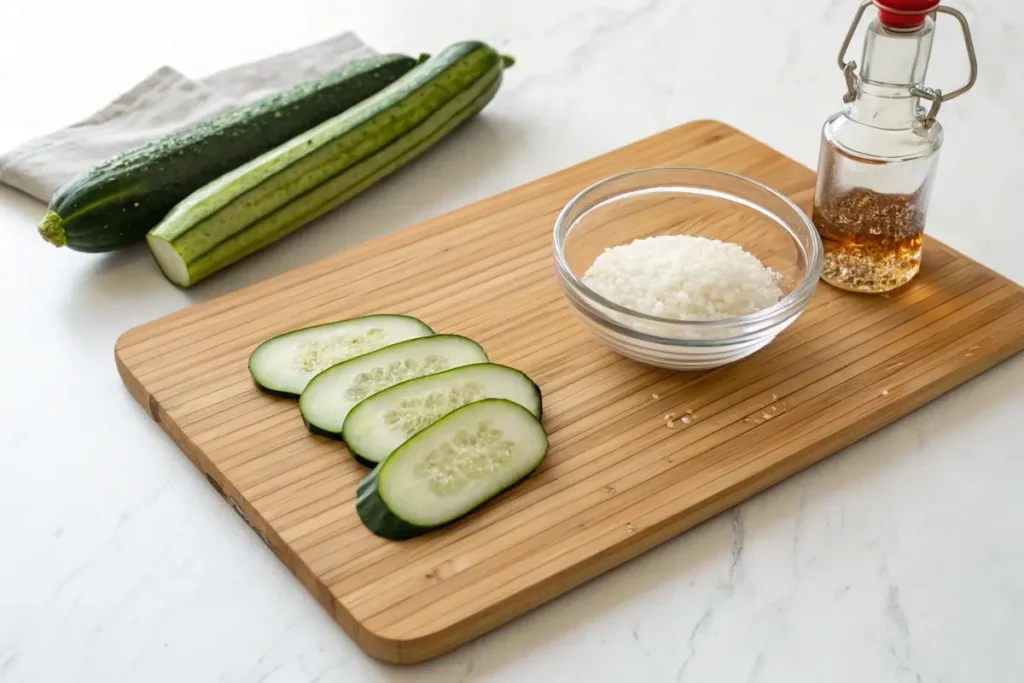
History and Context: Tsukemono vs. Sunomono
To truly appreciate the roots of a japanese cucumber salad recipe, it’s helpful to understand the broader history of pickling and vinegar-based dishes in Japan. While modern sunomono highlights quick-pickling, the tradition of preserving and flavoring vegetables in vinegar, salt, or rice bran goes back centuries.
Early Preservation Needs
In ancient Japan, long before refrigeration, pickling was a practical method to store surplus vegetables and ensure a year-round food supply. Farmers and villagers would brine daikon radishes, cucumbers, and other produce in large vats of salt or vinegar. This approach yielded tsukemono, which encompassed many preserved veggies used to complement daily meals.
The Evolution of Vinegar Use
Over time, vinegar production advanced, particularly rice vinegar, which became integral to Japanese cuisine. Vinegar not only preserved but also enhanced flavors, paving the way for simpler, fresher applications like sunomono. Rather than letting cucumbers or other vegetables ferment for extended periods (as with tsukemono), cooks found that a brief marination in a mild vinegar solution created a bright, crisp side dish. For a perfect example of this technique, try our Japanese Cucumber Salad Recipe for a light, refreshing addition to any meal.
Expansion of Varieties
As Japan opened trade routes and encountered new ingredients (such as sugar or soy sauce from China), these additions found their way into everyday cooking. The blend of sweetness and acidity that characterizes sunomono salad owes its existence to these influences. Meanwhile, the heavier pickling techniques for tsukemono endured, offering a stronger, more pungent flavor suitable for storing vegetables over months.
Modern Adaptations
Today, the lines between tsukemono and sunomono can blur in casual conversation, but chefs and foodies maintain a clear distinction. Tsukemono typically require longer curing times and stronger salt or brine solutions. Sunomono, on the other hand, is akin to a quick marinade or dressing, especially suitable for cucumbers, seaweed, or thinly sliced onions and carrots. For a refreshing take on sunomono, try our Japanese Cucumber Salad Recipe for a light and tangy dish perfect for any meal.
The Rise of Sunomono as a Global Favorite
As Japanese restaurants gained international recognition, sunomono emerged as a healthy, refreshing appetizer that introduced diners to the lighter side of Japanese flavor profiles. With minimal ingredients—cucumbers, vinegar, sugar, and perhaps soy sauce—this dish gained traction among health-conscious foodies. In some cases, it’s labeled as cucumber sesame salad or sesame cucumber salad on Western menus, highlighting its crunchy, seed-topped nature.
For a deeper dive into how other quick-prep items feature in Japanese cuisine, our Healthy Japanese Recipes page offers an array of wholesome dishes that expand on the concept of light, nutrient-dense meals. Whether you see sunomono as a cousin to tsukemono or a standalone quick salad, its place in Japan’s culinary timeline remains both historically significant and beloved.

Key Ingredients and Step-by-Step Preparation
Crafting a japanese cucumber salad recipe is all about striking the right balance of sweet, sour, and savory notes. Let’s dive into the essential components, along with a foolproof method for perfect sunomono every time.
1. Choosing the Cucumbers
- Japanese Cucumbers: Slim, seedless, and known for a crisp bite.
- Alternatives: Persian or English cucumbers; pick ones with minimal seeds and tender skins.
- Pro Tip: If using standard grocery cucumbers, peel off any waxy coating and scoop out large seeds.
2. The Dressing
A recipe for sunomono dressing generally calls for four main components:
- Rice Vinegar: Offers mild acidity and a subtle sweetness. (Try this authentic Japanese rice vinegar for the most balanced flavor.)
- Sugar or Mirin: Balances tanginess. Mirin also contributes slight thickness. ( We like this brand of mirin for subtle sweetness and depth.)
- Salt: Enhances flavors while drawing out cucumber moisture.
- (Optional) Soy Sauce: Adds an umami dimension, though you can skip it for a purely sweet-sour profile. ( Go for low-sodium Japanese soy sauce for a smoother umami kick.)
3. Soaking Cucumbers in Salt
Why soak cucumbers in salt water before making cucumber salad? This brief step:
- Draws out excess moisture, preventing sogginess.
- Firmly sets the crisp texture.
- Reduces bitterness in thicker-skinned cucumbers.
To do this, toss sliced cucumbers with about 1/2 tablespoon of salt. Let them rest for 10-15 minutes, then rinse and pat dry.
4. Additional Enhancements
- Sesame Seeds: Lightly toasted seeds add a nutty crunch, making it a cucumber sesame salad.
- Wakame Seaweed: Rehydrate dried wakame in water; then mix it in for an oceanic twist.
- Thinly Sliced Onions: For a sharper bite, soak onion slices in cold water to reduce pungency, then add them to the salad.
5. Step-by-Step Instructions
Ingredients (Serves 2-4 as a side):
- 2 Japanese cucumbers (or 1 large English cucumber), thinly sliced
- 1/2 tablespoon salt (for salting cucumbers)
- 2 tablespoons rice vinegar
- 1 tablespoon sugar (or 1 tablespoon mirin)
- 1 teaspoon soy sauce (optional)
- 1 tablespoon toasted sesame seeds (optional)
Method:
- Prepare Cucumbers: Wash and slice them into rounds, about 1/8-inch thick. Place them in a bowl and sprinkle with salt. Let them sit for 10-15 minutes.
- Rinse and Dry: Rinse off the excess salt under cold water. Pat the cucumbers thoroughly dry with paper towels or a clean kitchen cloth.
- Mix the Dressing: In a small bowl, whisk together rice vinegar, sugar (or mirin), and soy sauce if using. Adjust sweetness or salt to taste.
- Combine and Toss: Pour the dressing over the cucumber slices. Gently toss to ensure even coating.
- Add Toppings: Sprinkle sesame seeds or incorporate wakame seaweed if desired.
- Chill and Serve: Let the salad rest in the refrigerator for at least 10 minutes, allowing flavors to meld. Serve cold.
6. The Final Texture and Taste
Expect a crisp mouthfeel from the cucumbers and a refreshing tang from the vinegar-based dressing. Whether you call it sunomono salad or Japanese cucumber salad, it’s best enjoyed soon after preparation to preserve the crunch.
For more inspiration on incorporating vegetables into your meals, check out our Japanese Pumpkin Recipe for another classic side dish that pairs well with a variety of proteins. With just a handful of ingredients and a few simple steps, you’ll have a bright, palate-cleansing dish that instantly elevates any meal.
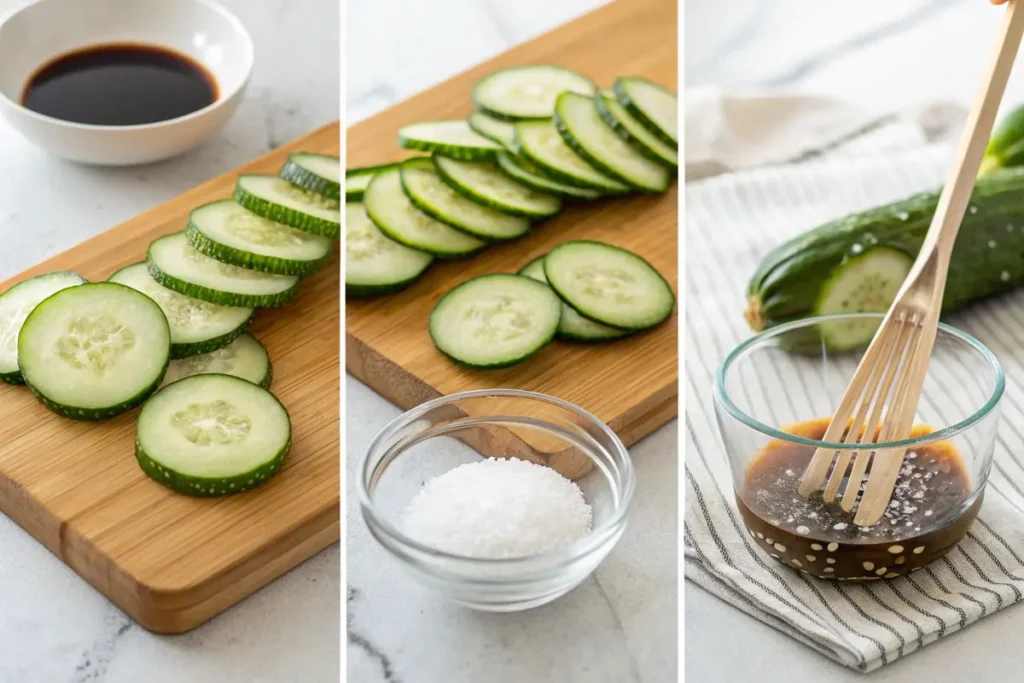
Practical Examples and Use Cases
From family dinners to potluck gatherings, japanese cucumber salad recipe works in countless scenarios thanks to its simplicity and refreshing taste. Below are several practical applications to inspire your meal planning.
1. Quick Family Side Dish
- Scenario: You’re short on time but want a healthy accompaniment to a main course.
- Approach: Prepare sunomono in the morning or early afternoon, so it’s chilled by dinner. Serve alongside grilled fish, miso soup, or japanese chicken fried rice recipe.
- Benefit: Minimal effort with maximum flavor, suitable even for picky eaters due to its mild sweetness.
2. Appetizer at Social Gatherings
- Scenario: You’re hosting a party or potluck and need a light, finger-food-friendly starter.
- Approach: Plate individual portions of cucumber salad in small cups or sake cups. Top with sesame seeds or a drizzle of sriracha for a playful twist.
- Benefit: Easy to distribute, visually appealing, and a welcome palate cleanser among richer dishes.
3. Work Lunch Prep
- Scenario: You aim to eat healthier during the workweek.
- Approach: Make a batch of sunomono and pack it in small containers. Pair it with rice balls (onigiri) or leftover proteins for a balanced lunch.
- Benefit: The tangy vinegar dressing helps keep cucumbers fresh, and the dish remains tasty even when chilled for several hours.
4. Creative Fusion Bowls
- Scenario: You’re building a grain bowl with diverse flavors.
- Approach: Layer quinoa or brown rice in a bowl, add sliced avocado, seared tofu, and a scoop of Japanese cucumber salad. Drizzle with extra dressing or a bit of sesame oil.
- Benefit: Introduces a bright, acidic element to an otherwise earthy bowl, tying flavors together seamlessly.
For additional ways to integrate Japanese-inspired dishes into everyday life, our Modern Japanese Breakfast guide showcases how creative meal planning can elevate simple ingredients. Whether you’re prepping lunches or hosting an event, Japanese Cucumber Salad Recipe sunomono’s crisp texture and tangy dressing adapt to myriad menus—making it an essential recipe for every cook’s repertoire.
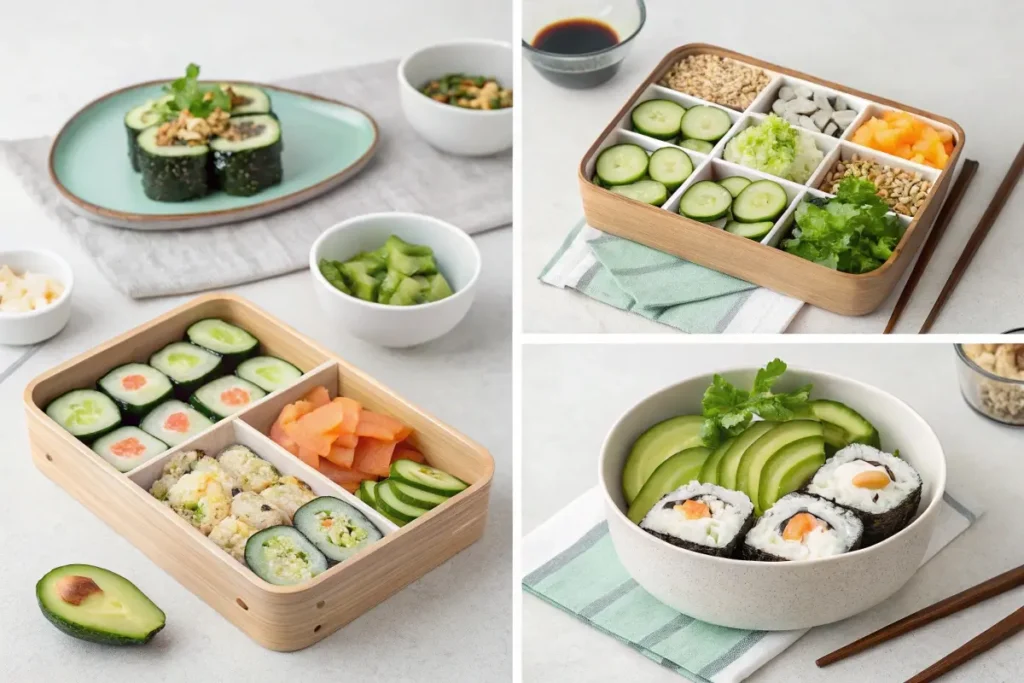
Common FAQs about japanese cucumber salad recipe
Below, we address popular questions about japanese cucumber salad recipe for those new to sunomono or seeking deeper insight. Understanding these details ensures your dish comes out perfect every time.

- What is the difference between Tsukemono and sunomono ‘japanese cucumber salad recipe’?
Tsukemono are Japanese pickles often cured for days or even months, resulting in bold, preserved flavors. Sunomono ‘japanese cucumber salad recipe’ is a quick-pickled salad, typically dressed in a sweet-vinegary sauce just before serving. It retains a fresh, crisp profile. - Can you eat Japanese cucumbers raw?
Absolutely. In fact, they’re commonly consumed raw in salads or as a crunchy snack. Japanese cucumbers have thinner skins and fewer seeds, making them ideal for raw preparations, including sunomono. - What is sunomono made of?
japanese cucumber salad recipe or Sunomono generally includes thinly sliced cucumbers, a vinegar-based dressing (often rice vinegar, sugar, salt, and optional soy sauce), and toppings like sesame seeds or wakame seaweed. Variations may include crab sticks, shrimp, or other additions for a heartier salad. - Why soak cucumbers in salt water before making cucumber salad?
Salting cucumbers helps remove excess water, which concentrates their flavor and enhances crispness. It also prevents the dressing from becoming diluted. After a short salting period, rinse the slices thoroughly to avoid oversalting. - Is this dish typically spicy?
No, japanese cucumber salad is more sweet and tangy than spicy. However, you can add a pinch of chili flakes or drizzle a bit of chili oil if you prefer a kick. - How long can I store it?
Ideally, enjoy sunomono the same day for maximum crunch. If you must store it, keep it in a sealed container in the refrigerator for up to one day. Beyond that, the cucumbers may lose their firmness.
For more insights on Japanese culinary techniques, consider exploring our Japanese Dessert Recipes to round out your meal with something sweet. Now that you know the answers to these common questions, you’re well-equipped to make and serve a flawless cucumber salad that showcases the magic of vinegary, refreshing goodness.
Conclusion for japanese cucumber salad recipe
In summary, a japanese cucumber salad recipe—commonly called sunomono—offers an effortless way to inject bright, clean flavors into your meal. By marrying crisp cucumber slices with a balanced vinegar-based dressing, you can craft a dish that complements heavier main courses or stands out as a refreshing appetizer. Whether you’re salting cucumbers to boost their crunch or adding a sprinkle of sesame seeds for extra texture, each small touch elevates this simple salad to a satisfying delight.
Remember that the key to success lies in choosing fresh cucumbers with minimal seeds, using a mildly sweet and tangy dressing, and not overcomplicating the recipe. For those who wish to experiment further, consider incorporating extras like wakame seaweed or protein options like crab sticks to create a more substantial sunomono. If you’d like to round out your table with more Japanese-inspired dishes, check out our japanese cucumber salad recipe and Japanese Barbecue Sauce Recipes for a savory contrast to the salad’s bright flavors.
Now that you have a deeper understanding—complete with the differences between sunomono and tsukemono, the reasons behind salting cucumbers, and the versatile ways to serve this dish—you’re all set to bring a piece of Japanese culinary tradition into your own kitchen. For a fresh and vibrant start, try our Japanese Cucumber Salad Recipe and enjoy the crunch, savor the zing!
